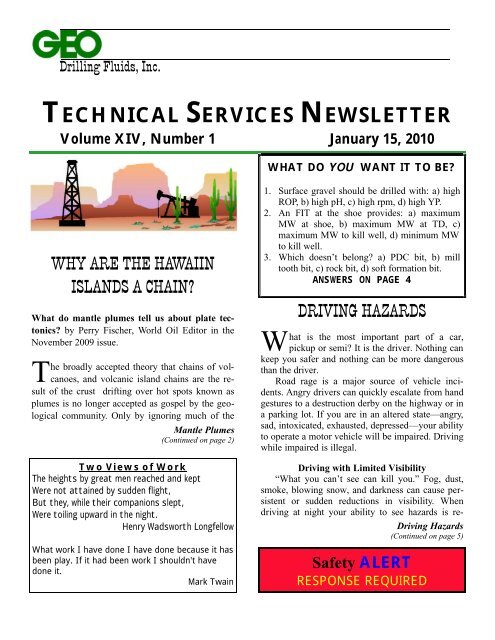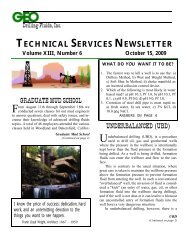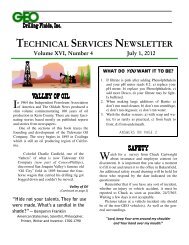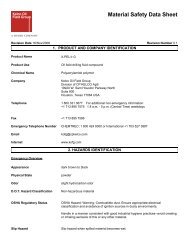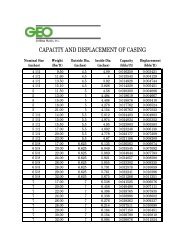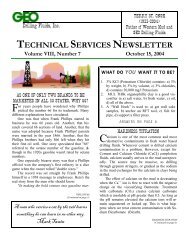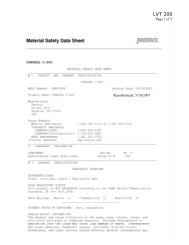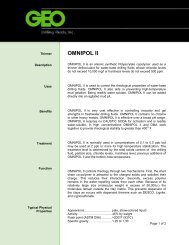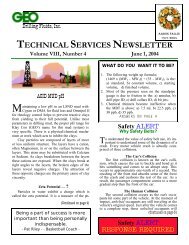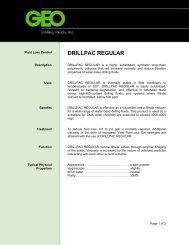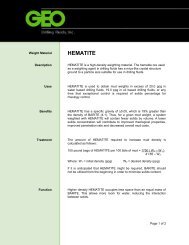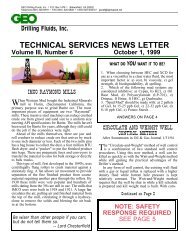Volume 14 Number 1 - GEO Drilling Fluids, Inc.
Volume 14 Number 1 - GEO Drilling Fluids, Inc.
Volume 14 Number 1 - GEO Drilling Fluids, Inc.
You also want an ePaper? Increase the reach of your titles
YUMPU automatically turns print PDFs into web optimized ePapers that Google loves.
<strong>Drilling</strong> <strong>Fluids</strong>, <strong>Inc</strong>.<br />
TECHNICAL SERVICES NEWSLETTER<br />
<strong>Volume</strong> XIV, <strong>Number</strong> 1 January 15, 2010<br />
WHAT DO YOU WANT IT TO BE?<br />
WHY ARE THE HAWAIIN<br />
ISLANDS A CHAIN?<br />
What do mantle plumes tell us about plate tectonics?<br />
by Perry Fischer, World Oil Editor in the<br />
November 2009 issue.<br />
T<br />
he broadly accepted theory that chains of volcanoes,<br />
and volcanic island chains are the result<br />
of the crust drifting over hot spots known as<br />
plumes is no longer accepted as gospel by the geological<br />
community. Only by ignoring much of the<br />
Mantle Plumes<br />
(Continued on page 2)<br />
Two Views of Work<br />
The heights by great men reached and kept<br />
Were not attained by sudden flight,<br />
But they, while their companions slept,<br />
Were toiling upward in the night.<br />
Henry Wadsworth Longfellow<br />
What work I have done I have done because it has<br />
been play. If it had been work I shouldn't have<br />
done it.<br />
Mark Twain<br />
1. Surface gravel should be drilled with: a) high<br />
ROP, b) high pH, c) high rpm, d) high YP.<br />
2. An FIT at the shoe provides: a) maximum<br />
MW at shoe, b) maximum MW at TD, c)<br />
maximum MW to kill well, d) minimum MW<br />
to kill well.<br />
3. Which doesn’t belong? a) PDC bit, b) mill<br />
tooth bit, c) rock bit, d) soft formation bit.<br />
ANSWERS ON PAGE 4<br />
DRIVING HAZARDS<br />
W<br />
hat is the most important part of a car,<br />
pickup or semi? It is the driver. Nothing can<br />
keep you safer and nothing can be more dangerous<br />
than the driver.<br />
Road rage is a major source of vehicle incidents.<br />
Angry drivers can quickly escalate from hand<br />
gestures to a destruction derby on the highway or in<br />
a parking lot. If you are in an altered state—angry,<br />
sad, intoxicated, exhausted, depressed—your ability<br />
to operate a motor vehicle will be impaired. Driving<br />
while impaired is illegal.<br />
Driving with Limited Visibility<br />
“What you can’t see can kill you.” Fog, dust,<br />
smoke, blowing snow, and darkness can cause persistent<br />
or sudden reductions in visibility. When<br />
driving at night your ability to see hazards is re-<br />
Driving Hazards<br />
(Continued on page 5)<br />
Safety ALERT<br />
RESPONSE REQUIRED
TECHNICAL SERVICES NEWSLETTER VOLUME XIV NUMBER 1 January 15, 2010<br />
Mantle Plumes<br />
(Continued from page 1)<br />
data can the actual facts be made to<br />
match this explanation. The classic<br />
example for Americans is the Hawaiian<br />
island chain that stretches<br />
from southeast to northwest across<br />
the central Pacific Ocean.<br />
The Hawaiian Islands are the<br />
tops of gigantic volcanic mountains<br />
formed by countless eruptions of<br />
fluid lava over several millions of<br />
years. Some tower more than<br />
30,000 feet above the sea floor and<br />
are the tallest mountains in the<br />
world when measured from their<br />
base. The volcanic peaks rising<br />
above the ocean surface represent<br />
only the tiny, visible part of an immense<br />
submarine ridge, the Hawaiian<br />
Ridge—Emperor Seamount<br />
Chain, composed of more than 80<br />
large volcanoes. This range stretches<br />
across the Pacific sea floor from the Hawaiian Islands<br />
to the Aleutian Trench. The length of the Hawaiian<br />
Ridge segment alone, between the Big Island<br />
and Midway Island to the northwest, is about<br />
1,600 miles. The amount of lava erupted to form<br />
this huge ridge, about 186,000 cubic miles, is more<br />
than enough to cover the State of California with a<br />
mile-thick layer.<br />
A key problem in explaining the formation of<br />
this mountain range arises where the Hawaiian<br />
Ridge meets the Emperor Seamount Chain, 650<br />
miles northwest of Midway Island. At this point<br />
there is a 45-degree dogleg in what appears to be a<br />
continuous string of volcanoes of ever increasing<br />
age.<br />
The explanation for the creation of these and<br />
similar formations remains a matter of research and<br />
discussion with no clear consensus. This is similar<br />
to the problem with continental drift. In 1915, Alfred<br />
Wegener first proposed that there was an original<br />
continent called Pangea. His detractors said<br />
PAGE 2<br />
Dogleg<br />
What formed the dogleg? Drifting plates, drifting plumes, or<br />
some unknown phenomenon?<br />
since he couldn’t explain why the continents were<br />
drifting and therefore his theory must be false. In<br />
the 1960’s when core holes drilled across the Atlantic<br />
proved him right there was a quick movement to<br />
explain the phenomenon of continental drift as a result<br />
of upwelling convection currents. With a halfcentury<br />
of research we now know far less about the<br />
driving force behind the drift phenomenon than we<br />
thought we knew at the end of the 1960’s. As we<br />
discover more and are less sure of the causes other<br />
areas fall into the unknown and the volcanic plume<br />
theory is one of those victims.<br />
“Whatever your interest in the geological sciences,<br />
know this: The paradigm of reasonably well<br />
defined lithospheric plates, sliding on layers of<br />
rock, propelled by convection, while deep-rooted<br />
plumes create mountain chains and hot mantle/lava<br />
flooded plains, is far from correct. We have a long<br />
way to go in our understanding of this dynamic<br />
planet we live on.”
TECHNICAL SERVICES NEWSLETTER VOLUME XIV NUMBER 1 January 15, 2010<br />
THE MUDMAN’S CORNER<br />
THE RIGHT ANSWER<br />
From the December Safety Alert: “The slightest<br />
presence of H 2 S in the air is normally detectable by<br />
its characteristic "rotten-egg" odor; however, it is<br />
dangerous to rely on odor as a means of detecting<br />
life-threatening amounts because the sense of smell<br />
is lost rapidly, allowing lethal concentrations to accumulate<br />
without warning.” It is False to assume<br />
there is a danger if you smell ANY H 2 S.<br />
PAPERWORK REMINDER!!!<br />
Every Mud Engineer is responsible for turning<br />
in paperwork. The person on duty at the end of a<br />
well must turn in all Delivery Tickets, Inventory<br />
Report, and Recap. The person on duty at the end<br />
of a well must turn in all Delivery Tickets, Inventory<br />
Report, and Recap. In addition, the electronic<br />
mud report must also be turned in. Do not<br />
rely on the owner of the computer to turn in the file.<br />
Use Flash Drive (thumb drive) or CD to copy the<br />
file and send or bring to the office in Bakersfield.<br />
If possible, e-mail the file to ajphil@geodf.com.<br />
BHA ON THE ELECTRONIC MUD REPORT<br />
The Electronic Mud Report requires the entry of<br />
Heavy Weight Drill Pipe (HWDP) and Drill Collars<br />
(DC). The DC or BHA section includes all DCs,<br />
MWD, Mud Motor, Stabilizers and subs. It does not<br />
include (for our purposes) the HWDP. For accuracy<br />
Desired<br />
Density<br />
(ppg)<br />
PAGE 3<br />
you should average the ID of all of the parts of the<br />
BHA as well as the OD’s. If there is no HWDP put<br />
in the Drill Pipe OD and ID and leave the length<br />
blank.<br />
USING SALT WATER FOR DENSITY<br />
Combining saturated salt waters to achieve a<br />
higher weight has a major problem. When saturated<br />
CaCl 2 (Calcium Chloride) and saturated NaCl<br />
(Sodium Chloride) are combined, a substantial portion<br />
of the salt precipitates out reducing the density<br />
of the water. Proper blending of salts to achieve a<br />
desired density must follow precise proportions.<br />
The table below shows how to do this.<br />
This first column shows how many pounds per<br />
barrel (ppb) of dry salt to add to obtain the mud<br />
weight on the left. The second column shows how<br />
to combine NaCl water with dry CaCl 2 to obtain<br />
higher densities than 10.0 ppg. Start with the indicated<br />
density of NaCl and add the pounds per barrel<br />
of CaCl 2 dry salt. The third column liquid CaCl 2 ,<br />
watered back to a particular weight then using dry<br />
NaCl to bring the weight up. Finally the method of<br />
combining saturated NaCl and saturated CaCl 2 requires<br />
the addition of fresh water. This chart shows<br />
what percentage of each is required to achieve the<br />
desired final mud weight.<br />
STUCK PIPE<br />
Stuck pipe ranks right up there with lost circula-<br />
The Mudman’s Corner<br />
(Continued on page 4)<br />
Composition of Calcium Chloride/Sodium Chloride Combined<br />
NaCl Dry + CaCl 2<br />
Dry ppb<br />
NaCl Water + CaCl 2 Dry<br />
CaCl 2 Water (at given<br />
density)+ NaCl Dry<br />
NaCl Water + CaCl 2 Water + Fresh<br />
water<br />
NaCl CaCl 2 Salt Water CaCl 2 Dry CaCl 2 Water NaCl Dry NaCl liquid CaCl 2 liquid Fresh<br />
ppg (ppb) ppg (ppb) 10.0 ppg 11.6 ppg Water<br />
10.1 88 29 9.7 29 80.8% 15.1% 4.1%<br />
10.2 70 52 9.4 52 64.3% 27.1% 8.7%<br />
10.3 54 72 9.2 72 49.6% 37.5% 12.9%<br />
10.4 41 89 9 89 37.6% 46.4% 16.0%<br />
10.5 32 104 8.8 104 10.2 32 29.4% 54.2% 16.5%<br />
10.6 25 116 8.7 116 10.4 25 22.9% 60.4% 16.6%<br />
10.7 20 126 10.5 20 18.4% 65.6% 16.0%<br />
10.8 16 135 10.7 16 <strong>14</strong>.7% 70.3% 15.0%<br />
10.9 13 <strong>14</strong>4 10.4 13 11.9% 75.0% 13.1%<br />
11.0 10 151 10.9 10 9.2% 78.6% 12.2%<br />
11.1 8 159 11.1 8 7.3% 82.8% 9.8%
TECHNICAL SERVICES NEWSLETTER VOLUME XIV NUMBER 1 January 15, 2010<br />
The Mudman’s Corner<br />
(Continued from page 3)<br />
tion and well control (kick) issues. These are all<br />
classified as Non-Productive Time (NPT) because<br />
until the problem is solved progress toward finishing<br />
the well has to be suspended. The cost of each<br />
of these events has to include the lost productive<br />
time as a function of hours of rig time lost.<br />
Spotting fluid on location ready to go is a cost<br />
that must be justified by the certain or possible cost<br />
of not having it on location when a stuck pipe event<br />
occurs. Differential sticking is one of the most common<br />
forms of stuck pipe. Spotting a fluid that will<br />
shrink the wall cake and provide lubrication can<br />
cure stuck pipe. The more quickly spotting fluid is<br />
placed the higher the likelihood that the pipe will be<br />
freed. Ron Coulter with Sun <strong>Drilling</strong> Products says<br />
“Experience has shown that getting a pill down hole<br />
in less than four hours provides a greater than 90<br />
percent probability of success”. Of course he is a<br />
seller of spotting fluids and has a vested interest in<br />
selling more spotting fluid. But if the spotting fluid<br />
is four hours away in a warehouse, the mixing and<br />
pumping equipment is in another company’s yard,<br />
and both require a callout time for drivers to get to<br />
the yards to pick up the equipment, it will be 12<br />
hours from the advent of stuck pipe before the spotting<br />
fluid reaches its destination. At this point, the<br />
chances of success have fallen to less than 50%.<br />
SAFETY AWARDS<br />
We have 44 employees who earned a safety<br />
awards for 2009. Congratulations to all! Your efforts<br />
have helped us improve our safety record almost<br />
every year for the last 10 years.<br />
Carlee will be calling each recipient over the<br />
next few weeks, if not before, to notify you and to<br />
verify your order. Please respond to her messages<br />
promptly so we can finalize purchases and embroidery<br />
as needed.<br />
During the next week or two we will have a<br />
drawing to select a winner of the semi-annual safety<br />
award. Everyone who earned a safety award this<br />
year is eligible. Your odds of being drawn increase<br />
with the number of consecutive awards you have<br />
won. If you have any questions about the details of<br />
the selection process please call Andy.<br />
The most common cause of loosing your safety<br />
award is failure to return the Safety Alert in time.<br />
There is a Safety Alert in this Newsletter so be sure<br />
to read the article and return the response form<br />
promptly. Any comments or suggestions would be<br />
appreciated.<br />
PRINTING TO PDF<br />
Quattro Pro has a few quirks as any one who<br />
has used our mud report program has discovered.<br />
One of these is the difficulty printing more than one<br />
PDF without turning off the program and restarting.<br />
Uncheck the “View PDF File” box to keep the<br />
computer from locking up when you print a second<br />
page.<br />
The solution to this issue usually works. Turn off<br />
“View PDF File”. At the bottom of the “Save PDF<br />
File As” screen is a check box. The default has the<br />
box checked so you can verify that what you got is<br />
what you intended. However, if you leave this box<br />
checked, then the second time you try to print to<br />
PDF the file will lock up. With the box unchecked<br />
this doesn’t happen, at least it doesn’t happen all<br />
the time. Just make sure you save your file before<br />
printing it with any device.<br />
1. d) high YP<br />
2. a) maximum MW at shoe<br />
3. a) PDC bit<br />
ANSWERS TO WHAT DO YOU WANT IT TO BE?<br />
PAGE 4
TECHNICAL SERVICES NEWSLETTER VOLUME XIV NUMBER 1 January 15, 2010<br />
Driving Hazards<br />
(Continued from page 1)<br />
duced by 50%. Sudden changes in speed in these<br />
conditions can be very hazardous. You are never<br />
“the last car in line”. Many accidents are caused<br />
when a car is struck from behind. Slow down to<br />
maintain enough distance from the car ahead to<br />
make a controlled stop in the event of trouble.<br />
Winter Driving Hazards<br />
Winter driving tips:<br />
1. For a commute of 30 minutes or less<br />
leave 10 minutes earlier than normal.<br />
For longer drives give yourself even<br />
more time.<br />
2. Review the weather forecast the night<br />
before. Check the weather on TV, radio<br />
or online before you leave.<br />
3. Clean, de-ice, or de-snow your windshield<br />
and mirrors BEFORE you start to<br />
drive.<br />
4. Use the defroster to keep all your windows<br />
clear.<br />
5. <strong>Inc</strong>rease following distance.<br />
6. Avoid distractions<br />
a. Cell phones – even with hands free.<br />
b. Eating while driving.<br />
c. Texting while driving.<br />
d. Reading maps, books or newspapers.<br />
e. Any activity that causes you to<br />
“steer with your knees”.<br />
7. Postpone any avoidable trips (like shopping)<br />
until the weather improves.<br />
8. SLOW DOWN.<br />
Speed<br />
Consider your speed in feet per second. 70 mph<br />
on the freeway may not seem that fast when you are<br />
trying to cover 150 miles to a rig, but at that speed<br />
you are covering 103 feet in one second. Taking<br />
your eyes off the road for two seconds to recover a<br />
dropped hamburger means you missed over 200<br />
feet of traffic, enough time to erase your entire<br />
stopping distance or for a vehicle to enter the roadway<br />
from behind a building or tree.<br />
Stopping distance is increased by the speed you<br />
are traveling, slick or wet road surface, and your<br />
reaction time which is a factor of age and alertness.<br />
PAGE 5<br />
The driver of this pickup had the right of way<br />
on a clear day with dry pavement. You have<br />
to practice defensive driving every minute you<br />
are behind the wheel.<br />
Reduced Visibility<br />
Stay on major roads during periods of reduced<br />
visibility. They are better marked, have wider<br />
shoulders, and are generally in better shape.<br />
DO NOT PASS when visibility is obstructed. If<br />
you think you have to listen for oncoming traffic to<br />
know if it is clear to make a left turn then that is a<br />
sure sign that visibility is too limited to make the<br />
turn. Use the right turn rule – make three right turns<br />
so you can cross the traffic at right angles instead of<br />
a left turn across traffic. Better still, go to a controlled<br />
intersection, make a u-turn and return to<br />
where you want to turn.<br />
In California, there are three reflectors 2100’<br />
from an off ramp, and some intersections. There are<br />
two reflectors <strong>14</strong>00’ from the turn and one more<br />
700’ from the turn.<br />
Daylight running lights are not headlights suitable<br />
for driving in fog. Force the lights to go to full<br />
headlights by turning on the lights or by covering<br />
the sensor on the dash that tells the lights to go on<br />
full at night. This is true of all Chevy pickups.<br />
Do not stop on the roadway. Do not stop on the<br />
paved shoulder. Pull all the way off the road if you<br />
must stop. Even this is illegal on Interstates except<br />
in an emergency. If you need to stop, go to the next<br />
Driving Hazards<br />
(Continued on page 6)
TECHNICAL SERVICES NEWSLETTER VOLUME XIV NUMBER 1 January 15, 2010<br />
Driving Hazards<br />
(Continued from page 5)<br />
exit or turn out to avoid being hit by drunk or<br />
sleepy drivers. When visibility is limited drivers<br />
may follow your tail lights right off the road and<br />
into the rear of your vehicle.<br />
Night driving is often the most dangerous time<br />
of all. This is even truer when other driving hazards<br />
such as snow, ice or fog are also present.<br />
Other Hazards<br />
Pedestrians, bicycles, and vehicles stopped by<br />
the side of the road present special hazards. Whenever<br />
any of these is present slow down and give<br />
them extra room in case of radical sudden movements<br />
like doors opening or “shade tree mechanics”<br />
with their legs sticking out from under a vehicle.<br />
Construction zones require slower speed and<br />
greater diligence. Watch for workers on foot close<br />
to the roadway.<br />
Wear seat belts whenever the vehicle is in motion.<br />
Anything in a vehicle can and will become a<br />
projectile during a violent crash and/or rollover.<br />
Unbelted passengers can kill other passengers as<br />
they fly around inside a car. A properly restrained<br />
baby was killed in Bakersfield when the car she<br />
was riding in rolled over. The child was fatally injured<br />
by a box of Kleenex.<br />
Once a collision happens there is no taking it<br />
back, no making it right and there is no fixing it. It<br />
can happen to anyone, even you!<br />
CUT HERE - Return Lower Portion<br />
<strong>GEO</strong> <strong>Drilling</strong> <strong>Fluids</strong>, <strong>Inc</strong>. ! P.O. Box <strong>14</strong>78 ! Bakersfield, CA 93302<br />
Telephone (661) 325-5919 ! FAX (661) 325-5648 !1-800-GETS<strong>GEO</strong> ! geodf@geodf.com<br />
SAFETY COMMUNICATION<br />
I have read the safety bulletin covering Situational Awareness in the <strong>GEO</strong> Technical Newsletter<br />
of January 15, 2010. VOLUME XIV NUMBER 1<br />
Print your name:<br />
Signed:<br />
Date:<br />
Comments:<br />
1. When driving at night your ability to see<br />
hazards is .<br />
2. Any activity that causes you to “steer with<br />
your knees” is .<br />
3. Daylight running lights are<br />
for driving in fog.<br />
Please answer the questions, sign, date and return to Andy Philips, Safety Coordinator / Technical<br />
Services Manager within one month of publication date. Any comments would be appreciated.<br />
E-mail response accepted.<br />
Thank You.<br />
PAGE 6


